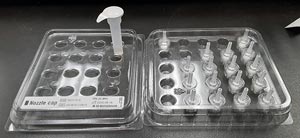Three Health Canada approved rapid antigen detection (RAD) commercial kits were tested against Covid-19 proficiency testing samples to compare their performance.
Kits were tested against different dilutions of the reference material and after the sample had been incubated under different temperatures for 7 days.
We used our standard positive sample (1/10 dilution of the inactivated virus material provided by BCCDC – see or Summer 2021 issue) to make 1/50 and 1/100 final dilutions of the material and see if the three kits were able to detect the positive sample.
The different dilutions were left for 7 days at different temperatures: room temperature (RT), 4°C, and 35°C and re-tested with the different kits.
Observations
The three antigen kits were simple and straight forward to use, with the FaStep having one extra 2 min incubation before adding the sample to the testing device; Standard Q was the most straight forward as it had already extraction buffer aliquoted in the extraction tube.



Sensitivity Results
When testing our simulated sample on the day of production, the three kits gave a strong positive result for dilutions A (1/10) and B (1/50) and a positive result for dilution C (1/100).
Dilution D (1/1000) was not detected by the PanBio nor the Standard Q kits; a very faint band was observed in the FaStep kit.
All three kits gave good results for all temperatures after 7 days for dilution A (1/10) and B (1/50). Although the tree kits were able to give positive results for dilution C (1/100) after 7 days incubation at 35°C, the result was hard to call for the Panbio and FaStep kits.

Overall, the three kits performed well with similar sensitivities although the SD Biosensor Inc. Standard Q consistently gave stronger and sharper bands which would make the assay easier to interpret.
It is important to note that the three kits had different type of swabs that could take different amount of sample. The swab provided with the Panbio kit took the smallest amount while the Standard Q absorbed al the sample; that could explain the differences in band intensity.



